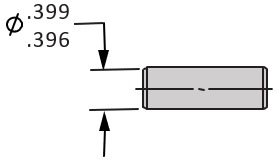GTOL Rule #1
For the pin shown, answer the following questions:
- According to Rule #1, also known as the limits of size, the size tolerance applied to a feature of size controls what?
- What is the max amount of bow allowed on the pin?
- If the pin were produced at a diameter size of .399, what is the max form variation allowed?

Expand Hint
Per ASME Y14.5, Rule #1 is:
“Where only a tolerance of size is specified, the limits of size of an individual feature prescribe the extent to which variations in its geometric form as well as size, are allowed.”
Hint 2
The feature’s form may vary within the size limits. At MMC, the form must be perfect. As the it drifts from MMC to LMC, the feature may be more bent, tapered, or out of round. This guarantees fitment at the next level assembly.
The limits of size (Taylor Principle, Envelope Principle, Rule #1) defines the form and size limits of individual, regular features. For most common situations, it requires perfect form at Max Material Condition (MMC) to ensure a component will fit inside an opening. Per ASME Y14.5:
“Where only a tolerance of size is specified, the limits of size of an individual feature prescribe the extent to which variations in its geometric form as well as size, are allowed.”
The feature’s form may vary within the size limits. At MMC, the form must be perfect. As the it drifts from MMC to LMC, the feature may be more bent, tapered, or out of round. This guarantees fitment at the next level assembly.
Thus, Rule #1 controls size and form. To find the max bow allowed:
$$$.399-.396=.003$$$
Since .399 is the MMC, then the form must be perfect. So, the max form variation allowed is: .000
- Size and Form
- .003
- .000
Time Analysis
See how quickly you looked at the hint, solution, and answer. This is important for making sure you will finish the FE Exam in time.- Hint: Not clicked
- Solution: Not clicked
- Answer: Not clicked
Similar Problems from FE Sub Section: Modifying Symbols
053. GD&T
072. Tolerance Analysis
215. Positional Tolerance
402. GTOL
404. Feature Control Frame
409. GDT Symbols
411. GDT Rule #1
415. Geometric Symbols
417. ASME Y14.5 Symbols
421. RFS Boundaries
422. LMC Boundaries
423. MMC Boundaries
425. A Hole’s Virtual Size
426. A Pin’s Virtual Size
427. MMC Hole’s Virtual Size
428. MMC Pin’s Virtual Size
438. Accept or Reject?
Similar Problems from FE Section: Geometric Dimensioning and Tolerancing (GD&T)
053. GD&T
072. Tolerance Analysis
092. MMC vs LMC
215. Positional Tolerance
398. MMC & LMC
402. GTOL
404. Feature Control Frame
409. GDT Symbols
411. GDT Rule #1
415. Geometric Symbols
417. ASME Y14.5 Symbols
421. RFS Boundaries
422. LMC Boundaries
423. MMC Boundaries
425. A Hole’s Virtual Size
426. A Pin’s Virtual Size
427. MMC Hole’s Virtual Size
428. MMC Pin’s Virtual Size
438. Accept or Reject?